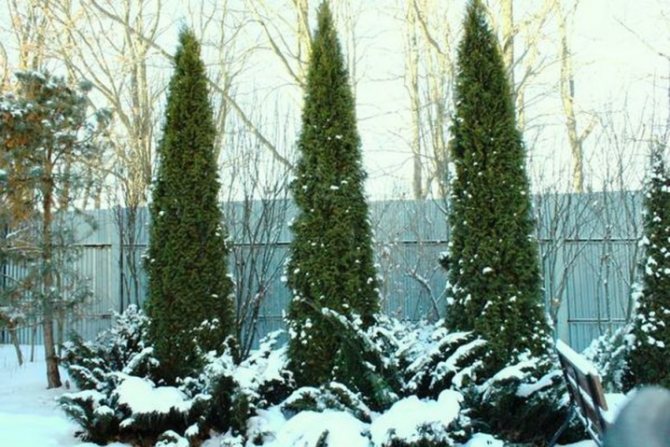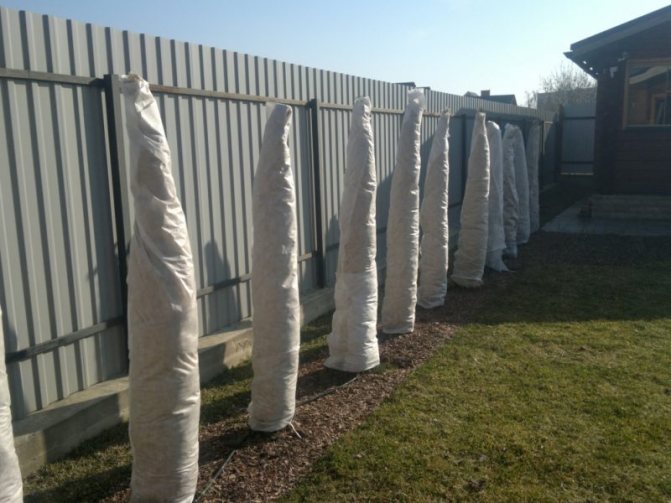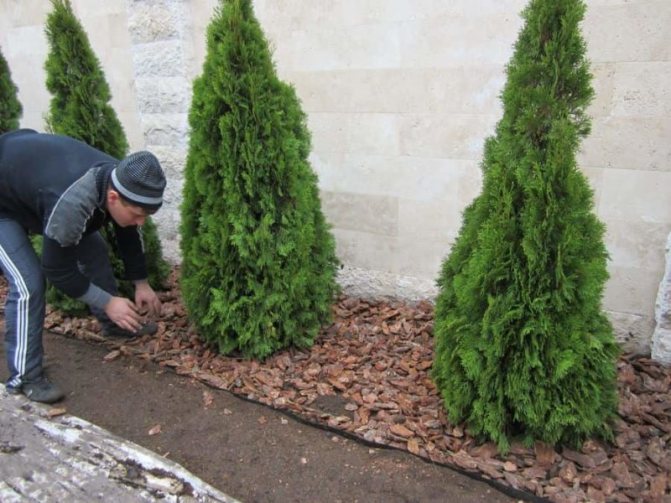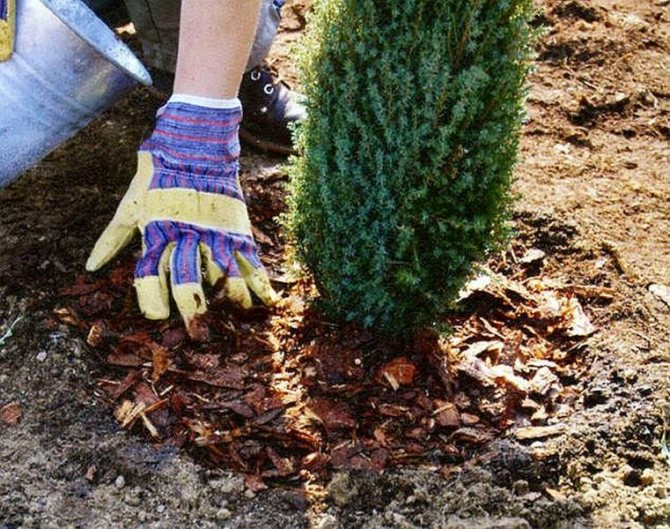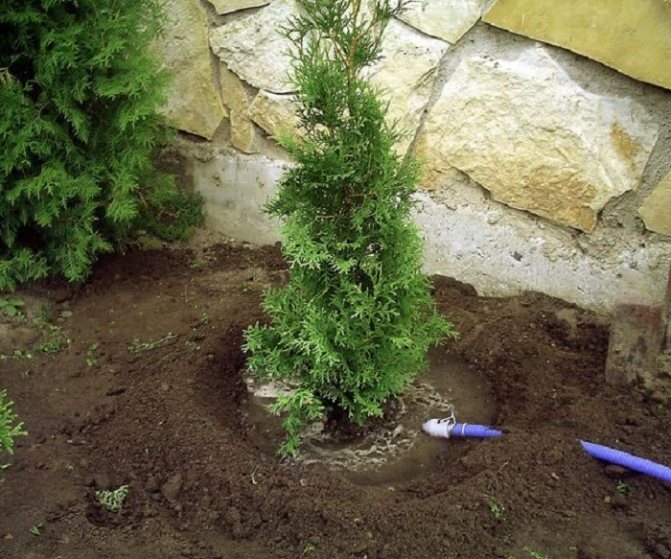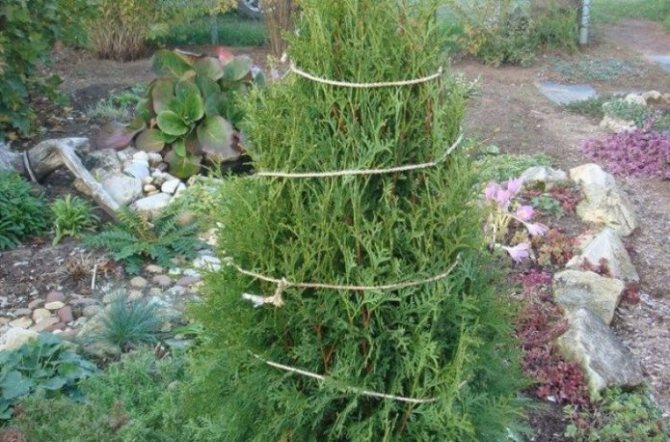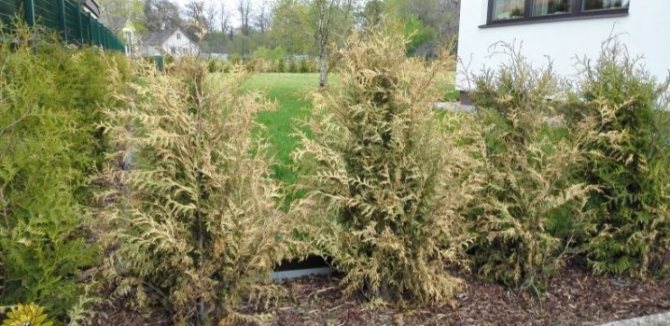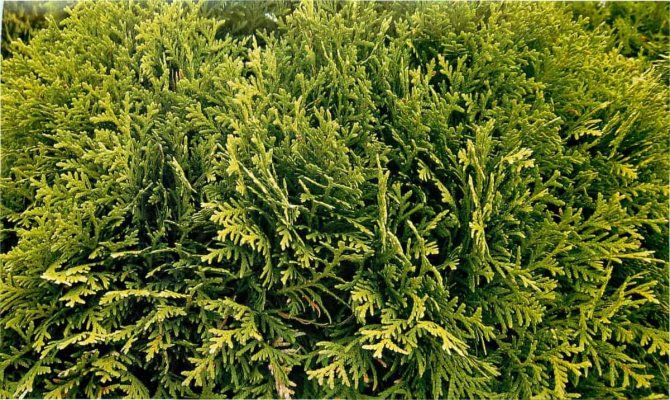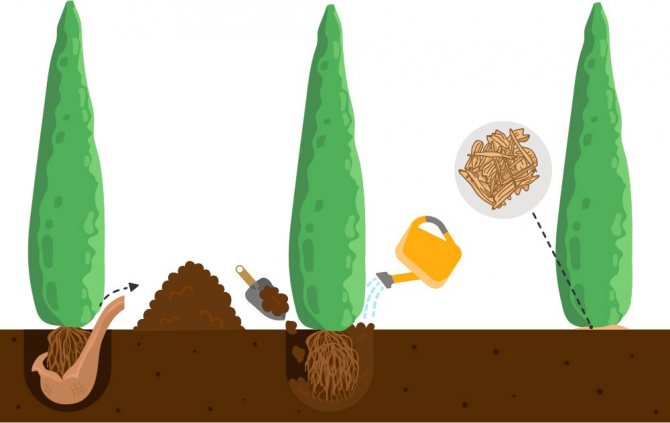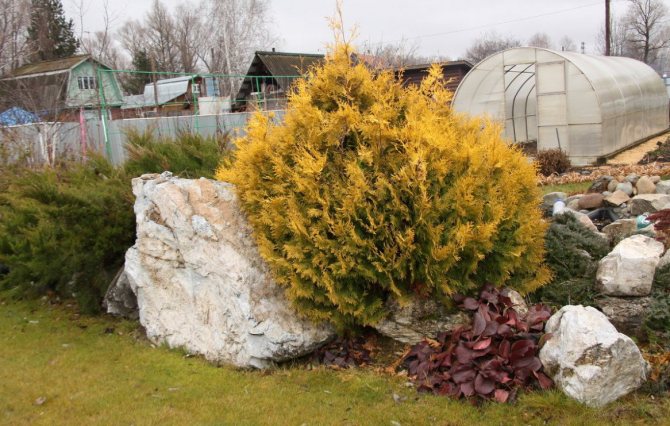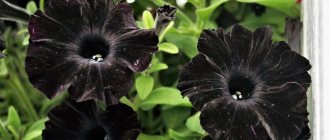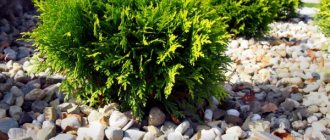Description
This plant is not found in Russian climatic conditions. His homeland is America and East Asia. But the tree has taken root quite well in our environment. Some of its varieties are grown even in the north of Russia.
Interesting. The word "tuya" means "incense" or "sacrifice". This is associated with the pleasant aroma that spreads during the burning of some plant species.
The plant belongs to Cypress. It is evergreen, the needles consist of scales overlapping each other. At home, it almost always grows to a height of 20 m, but in Russia it rarely reaches 11 meters in height.
There are such types of thuja:
- Thuja western ("Smaragd") - the most common type in gardening. It has a large number of varieties.
- Japanese thuja grows in highlands. Its difference is beautiful needles with different colors. In a summer cottage it can have a height of up to 18 m. In large cities it takes root with difficulty.
- Korean thuja has a wide, spreading crown and soft needles.
- Folded thuja is very sensitive to cold. The plant is very tall and can reach a height of 60 m. It has a pleasant aroma.
- Eastern thuja has medicinal properties. Its branches resemble a fan. The plant does not tolerate frost well.
Landing rules
Thuja can be planted from spring to autumn. But the best trees take root on the site in April-May. They get sick less, adapt faster to new conditions and start growing earlier. The autumn planting of thuja is associated with significant risk. There is no certainty that the tree will have time to take root well on the site before the cold weather
Thuja planting pits need deep and wide - usually about 80-100 cm. Their exact dimensions are determined by the volume of the tree root system. It should fit freely in the pit along with the soil clod. Usually, the width of the hole is made 40 cm, and the depth is 30 cm more than it. At the bottom of the pit, loose soil filled with fertilizers is poured. Wood ash, humus, compost are well suited. Such a planting will facilitate the care of the thuja: the plant will need to feed only 2-3 years after it.
If the roots of the tree are dry, they are briefly dipped in a container of water. Having placed the seedling in the hole, sprinkle it with a mixture of earth, peat and sand, taken in equal amounts. If its roots were open, they are spread over an earthen mound. When planting a thuja with a closed root system, it is carefully removed from the container along with the substrate, placed in a pit and covered with soil. The soil around the seedling is lightly tamped and watered well (1-2 buckets of water). When properly planted, the root collar of the thuja is at the level of the soil. The earth in the near-trunk circle is mulched. Well suited for this:
- peat;
- compost;
- chopped pine bark.
That's right, the mulch only covers the soil. On the lower branches of the plant or on its trunk, it should not be, otherwise they will vytuyut.
The layout of the thuja in the country depends on the selected varieties. Tall trees are planted at intervals of 4-5 m. Between the undersized trees, at least 1 m of free space is left. At the same distance, thuja are placed in the garden so that they form a hedge or a shady alley. The height of the tree does not matter here.
Plant care
Caring for thuja in spring and summer is not particularly difficult. If you follow all the recommendations, the plant will not hurt and will tolerate adverse climatic conditions well. How to care for thuja depends on its condition.
Landing
These trees give seeds. They have bumps, each of which has seeds. They ripen by autumn and at this time are already suitable for reproduction. A seedling grows from a seed. It has been growing for 5 years. During this time, the plant adapts to harsh winters. The seeds can also be grown at home in a pot.
Choose a sunny place for planting. The soil must be nutritious. Seeds are best planted in spring. The depth at which the seeds should be is no more than 5 cm. The place where this coniferous tree is sown should be sprinkled with a small layer of sawdust from the needles.
Young shoots will grow from these seeds. They should be protected from direct sunlight. You need to be very careful when weeding because the young shoots are very tender.
Note! Seedlings can die in direct sunlight, so planting sites should be shaded.
The soil under these plants needs to be loosened and constantly moistened. The shoots should be fed with slurry with manure. For its preparation, manure should be diluted in water (for 1 liter of water - 50 g of manure).
Reproduction by shoots
Thuja can reproduce with the help of shoots. To do this, you need to prepare cuttings from shoots that are 2, or even better 3 years old. The growth can also be planted, but it must have a piece of old wood. Cuttings are treated with a special preparation - heteroauxin.
For better rooting of cuttings, you need to use sod land and peat. Cuttings are planted to a depth of no more than 2.5 cm. It is best to take care of them in a greenhouse (in these conditions, they can be protected from direct sunlight).
Watering
Gardeners are interested in how often to water the thuja. For plants planted in the warm season, watering of the thuja is required once a week (if the weather is not hot). If the air is very dry and hot, watering is increased up to 2 times during the week. Under each shrub, you need to add at least a bucket of water.
During the first month of life, the plant needs to be sprinkled. With this type of watering, the pores open and the tree begins to breathe. It is necessary to irrigate the trees once a week. Its further growth depends on how to water the thuja.
Watering has not been stopped since about August. It is needed for the plant to gain moisture for a good wintering.
Important! An excess of watering is no less humid - the plant does not like it and can get sick with fungal pathology. How often to water the thuja after planting in the summer depends on its resistance to fungal diseases.
Top dressing
Gardening enthusiasts are interested in how to feed the thuja in the summer.
When feeding, you should pay attention to the following recommendations:
- Top dressing is done only in spring and summer; at other times it is inappropriate to do it.
- It is recommended to use the Zircon solution, which has a beneficial effect on the growth of the root system and on the absorption of useful components by the tree.
- In the spring, it is recommended to spray the trees with Iron Chelate. It prevents the development of chlorosis.
- With a decrease in the intensity of growth, use "Megafol", "Vermiculite".
Loosening, mulching
It is necessary to loosen the soil near this plant to a depth of at least 10 cm. This is due to the location of the plant's root system.
Read also: Technology of installation of soft tiles
Haircut and trim
Thuja summer care methods involve mulching. It is carried out using peat. Its layer should not exceed 7 cm.
Haircut and trim
In order for a tree to develop correctly and have a beautiful crown, it must be pruned.Most species in the process of growth acquire some form of crown. With the help of cropping, you can give it the desired look. Sanitary pruning is required if yellow, damaged branches appear.
The frequency of pruning depends on the intensity of growth (it does not exceed 35 cm per year, in some varieties it reaches 10 cm during the year). The timing of the formation of the crown is regulated as follows:
- When budding - about 10 days after the average temperature outside has reached the 10-degree mark.
- During flowering, shoots are cut in the north-western region - at the end of May or early June, in the middle lane - in mid-May, in the south - in April.
Important! If you cut the thuja before it starts to bloom, you can suspend its vegetation.
Choosing a place for growing thuja
For planting thuja, it is necessary to choose not a shady area, but protected from direct rays of the sun and without drafts and sudden gusts of wind. With the right choice of place, the plant will not turn yellow from sunburn and cold wind, which means it will retain its decorative qualities for a long time.
The soil on the selected plot of land should be fertile and slightly moist. It is desirable that groundwater flows at great depths. It is recommended to pour a special soil mixture consisting of peat, turf soil and coarse sand into the planting holes, and ideally, such soil should be on the entire area where thuja grow.
This is a troublesome business and only patient and persistent gardeners can do it. With seed propagation, a full-fledged plant can be seen only after 4-5 years. It takes a lot of effort and time, but the results are worth it. Practical advice on the selection of seeds, their preparation and cultivation will make the process easier for novice amateur gardeners.
When using freshly harvested seed material from plants that are grown at home, the varietal qualities of thuja are practically not preserved, only its external indicators remain.
Seeds can be harvested during the fruiting period of mature plants. Fruits - cones, together with seed shoots, must be separated from the mature shoot and left in a warm and dry place until fully ripe, spreading them on a flat surface at a short distance from each other. After 3-4 days, the cones will dry out and open - this is a signal to collect seeds.
Among the methods of planting seeds, there is the simplest one - it is sowing seeds in individual pots with fertile soil. True, the success rate of such cultivation is low. Seeds germinate with this method for a very long time.
It is more efficient to sow stratified seeds or plant in autumn (before winter). When planting before winter, it is recommended to use only freshly harvested seed material that has not been specially treated (soaked with a biological solution). It is immediately planted in moist fertile soil.
Autumn planting will bring the first shoots with the warming of the first spring sun. The appearance of thuja seedlings is similar to young dill greens. The first needles on the seedlings will appear in about a month, and the first shoot will appear only after six months. With strict adherence to all the rules of care and maintenance, the plant will reach 10 cm in height in a year.
To increase the germination of thuja seeds several times will help a special procedure - seed stratification. Freshly harvested seeds must be sorted - remove all small, weak and damaged specimens. The best seed should be mixed with damp sawdust or moistened sand, placed in a tightly closed plastic container and kept in a cool place for at least 90 days. It is recommended to inspect the seeds for mold once a week and to keep the mixture from drying out.
After stratification, the seeds must be planted in a prepared soil mixture, around the end of February. The seedling box is filled with coniferous substrate or any nutrient soil mixture. A drainage layer is preliminarily poured onto the bottom of the box. Sea pebbles, fine coal or expanded clay are suitable. After the seedlings appear, you need to provide them with sufficient lighting (you can additionally use fluorescent lamps).
Do not forget about preventive measures. A pink solution of potassium permanganate will help to resist fungal and infectious diseases, with which the soil is abundantly moistened before planting seeds.
Seeds should be planted in moderately moist soil in a checkerboard pattern. The distance between the seeds is at least 2 cm. Each seed must be pressed a little into the soil and sprayed liberally from a sprayer.
The temperature, which will contribute to the rapid germination of seeds and the full development of seedlings, is 20-22 degrees Celsius. Before emergence, the planting box should be under a dense transparent cover in a dark place. After the emergence of seedlings, the container must be rearranged in a bright and warm room. Plants should remain under a glass cover for a month and a half, that is, until the seedlings grow up and get stronger.
When young shoots reach 2-3 cm in height, they must be carefully sprinkled with a thin layer of fine dry sand and sprayed with a spray bottle. Such moistening is carried out regularly in moderate amounts.
Every day, the container with seedlings must be ventilated, young crops must be irrigated, and weak or diseased plants must be removed.
In the first year of life, young plants need regular watering, sufficient lighting, and top dressing in the form of a nutritious soil mixture. The picking process at this stage is not recommended.
Wintering for young plants is dangerous, so it is advisable to rearrange the containers with seedlings for the winter in greenhouse conditions or keep them at home temperatures. It is possible to use a special plant cover as protection against frost.
The optimal time for the first transplant is in the third year of rearing. In early spring, a transplant should be carried out only by the method of transshipment of an earthen coma. This will ensure the preservation of the root part and the further health of the young thuja. When warm spring weather is established, containers with plants can be transferred to the open air, and it will be possible to transplant thuja to an open place already in early September.
Pruning
This procedure is carried out periodically (at least once a year) as the plant grows to form a lush and beautiful spherical crown, as well as to remove dried shoots and yellowed branches. It is recommended to trim the shoots to about one third of their length.
Fertilization
Regular feeding is the key to the full development of thuja. It can be complex mineral fertilizers or various organic fertilizers. They are essential at all stages of plant development. Fertilization methods can be different - from applying to the soil and digging to adding them to irrigation water. The last feeding is carried out at the end of August.
Preparing for winter
Using a non-woven material and a mulch layer, it is recommended to cover all thuja plantations for the winter, and especially young plants. As a mulch, you can take shredded tree bark, peat or any organic matter. The cover is removed after the snow has completely melted.
Thuja's cuttings are the most common and most effective breeding method. It is necessary to choose the healthiest cuttings about fifty centimeters long, cut them off with a heel, hold for some time in the Kornevin solution and plant them in the soil mixture, deepening each cutting by about 4-5 centimeters.
The soil mixture can consist of turf and peat soil and fine sand in equal parts. Planting cuttings is recommended to be kept under a glass cover, periodically opening it for airing and spraying. The root portion will begin to form in about 20-30 days. Rooted cuttings can be transplanted to an open area only for the next season.
Plant care in autumn
Thuja requires careful care in the fall. After September, the tree must be cut and insulated. Dead branches should be removed.
You can prune the plant in warm weather at a temperature of at least 4 ° C. Pruning is not done just before frost - branches need time to recover and frost can damage them.
Thuja care in autumn
After pruning, the tree needs to be fed and watered.
Warming for the winter is carried out in the following order:
- The roots are insulated with straw, compost, manure, peat (layer - up to 30 cm).
- Cover the crown of a young tree with a five-liter bottle.
- The crown of an adult tree needs to be wrapped with a layer of thick paper.
- The bark must be protected from sunburn with shields.
Leaving after winter. When to disclose?
Important
so that in winter the thuja is protected from snow blockages. The opinion that a plant will be warmer under a layer of snow is fundamentally wrong.
Thuya is opened when the snow melts and the air warms up. but it is not worth rushing with the disclosure
... The first rays of the sun can cause irreparable harm to the plant. Thuja can simply get burned. From this, the branches will turn yellow and dry.
The ideal option would be to install after opening special shields to protect the thuja from the sun. With the beginning of spring, the plant must be watered abundantly.
Diseases and pests
Thuja pests are:
- motley moth, leading to the death of the tops of the shoots;
- false shield (affects young processes);
- click beetle (damages the root system).
For pest control, pyrethroids, karbofos, actellic are used. Spraying with solutions of these drugs is carried out.
Tuyu can be amazed by:
- phytophthora, which destroys the root of the plant, which makes it wither, and the trunk becomes soft;
- brown shoots (some scales turn yellow);
- fusarium.
You can prevent the development of these diseases with the help of fungicides. Fundazol is used to combat fusarium.
Thuja is a plant that requires proper care and maintenance. Correct pruning of the plant allows you to form a beautiful decorative crown and make the garden unique.
Because how correctly you will take care of the thuja in the fall, the longevity and appearance of the plant depends. When and how to fertilize an evergreen tree and what fertilizing is better to refuse, how to cut it and prepare it for the winter cold, what mistakes should be avoided: we will talk about this in more detail later.
Mycorrhizal preparations for thuja
Mycorrhizal vaccines can be used in addition to fertilizers. The preparations contain mycorrhizal fungi, which have the following effect on plants:
- increase the absorbency of the root system;
- improve water supply;
- reduce sensitivity to environmental stress;
- increase resistance to fusarium, late blight and other diseases;
- stimulate root growth;
- increase the availability of nutrients.
With proper feeding of thuja, competent care, the plant will delight with a beautiful appearance, green needles.
Autumn care for thuja
With proper care in the fall and the necessary operations to prepare the plant for winter, you will provide it with the necessary conditions for successful wintering. What you should pay attention to:
- Plant feeding.
- Stimulation of the root system.
- Watering.
- Pruning.
Stopping the application of nitrogen fertilizers
In the fall, you should stop feeding the thuja with nitrogen. This fertilizer stimulates the formation of young shoots.By the beginning of cold weather, they will not have time to get stronger and may die over the winter. Top dressing with this fertilizer should be carried out for the last time in mid-August.
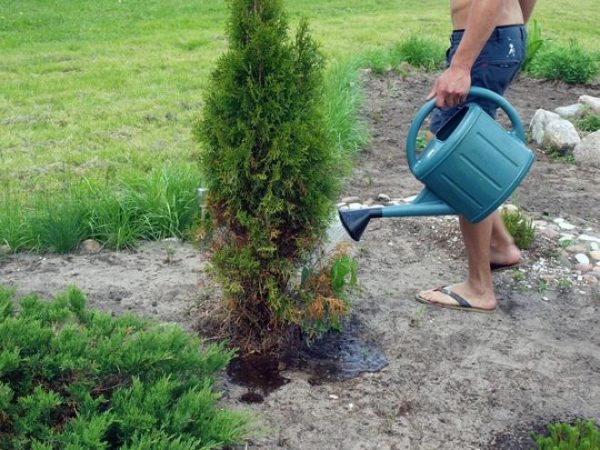
Root system stimulation
Another, no less important operation that you must carry out in order to properly prepare the thuja for winter is to stimulate the root system. Not everyone needs it, but only young shoots and those plants that were transplanted to a new place before winter. To do this, treat the shrub with drugs that stimulate root growth: Kornevin or Zircon. Dilute the preparations in 10 liters of water: Kornevin - 10 g, and Zircon - 40 drops. Water the tree with the resulting solution. A few days after this procedure, it is required to water the bush with 30 liters of water, pouring it into the trunk circle. This procedure is needed to drink moisture from the roots and prevent them from freezing.
Watering
If the region in which you live is characterized by autumn without a lot of rainfall, then you should regularly water the thuja. The coniferous bush loves moisture, but keep in mind that its excess will lead to rotting of the roots. Water the plant abundantly before winter. Then the moisture will saturate the roots for a long time, and the frozen ground around the bush will protect them from hypothermia due to the longer freezing of the soil.
Pruning
Pruning is another essential step in the fall maintenance of a coniferous tree. It provides him with healthy development and beauty of form. It is very important not to overdo it when pruning a coniferous bush in the fall. If you bare him too much, then he will not have time to recover and may not endure the winter cold.
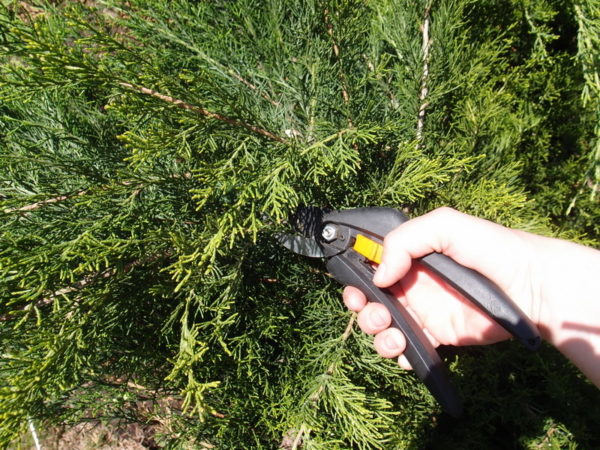

What is pruning for? You need to prune, first of all, to remove dry and diseased shoots. Untimely processing can lead to the death of the entire thuja.
It so happens that not all of the branch is affected, but only a small part of it. Then you shouldn't delete it completely. Cut off only the affected part. You can only run your hand along the branch, and the dried, diseased needles will fall off by themselves. You may well expect that in the place of the fallen, healthy needles will grow and the tree will be saved.
Read also: List the structural features of the cap mushroom
Additionally, the thuja is cut to correct the shape. To keep the bush in its original appearance, cut off the trunks that have grown strongly upward. This will also allow the side branches to grow. By pruning the tree, you create good air circulation and protect it from pests.
Thuja tolerates procedures for removing unnecessary processes in both spring and autumn. Nothing bad will happen if you prune a third time. There is no clear time frame for trimming. The main condition that you must adhere to when processing a plant is dry weather without precipitation and an air temperature of +4 degrees.
It is important to properly trim the thuja. To do this, follow these steps:
- Remove any dried, insect-damaged branches from the top of the coniferous bush.
- Cut off any sprouts that have come out upward.
- Remove excess branches from the inside of the plant.
You can shape any shape of the coniferous bush you want. Purchase a metal sculpting mold from your garden supply store and place it over the plant. When the free spaces are filled with shoots, remove the shoots protruding upward. This manipulation is called topiary haircut. In addition to it, there is a spherical and spiral pruning. These types of haircuts are carried out in the likeness of topiary pruning: the branches that stick out upward are removed until the bush acquires the desired shape.
Rehabilitation
In the first few years
thuja will be especially sensitive to the changing seasons. Therefore, after the cold period, there will be a complete or partial fall of the needles, yellowing and drying out. But if you follow all the rules of care, over time the tree will adapt and will calmly endure winters.
It is better not to open thuja immediately with the arrival of spring, but to do it gradually.At first, 2 hours a day, so that the plant slowly gets used to the sun. Otherwise, sunburn will severely damage the tree.
If the tree has already suffered from the sun, it must be sprayed once a week with a special solution.
The sun is not the only reason for yellowing. Sometimes the needles can turn yellow due to increased alkali content in soil
.
This can be easily checked using special test strips sold at any garden store. A slightly alkaline or slightly acidic soil will be preferable for thuja. Sometimes the soil is acidified with a small amount of peat.
After winter, young plants will be weakened, and therefore they will easily succumb to the influence of pathogenic microorganisms. With the onset of spring, the thuja must be treated with fungicidal preparations.
By a young tree
it is better to remove dried needles with your hands, and not cut them off. It will be possible to prune with scissors next year, when it will be seen which branches are really completely dry.
It will take 2-3 years for a young thuja to fully get used to weather conditions. To maintain a beautiful shape, it is better to cut new shoots with a pruner. In this case, no more than one third of the shoot should be cut off.
So, despite all its unpretentiousness, thuja in winter requires attentive attitude and proper care
... Only in this way will she delight with her beauty for a long time. If the simple rules of care are not followed, the plant can die during the severe winter cold.
Summer residents love to decorate their plots with unpretentious evergreen shrubs and trees, which always look elegant. Planting and caring for them is not burdensome, and thuja live in the open field for a long time. They were called "royal trees" for a reason. Tui are frost-resistant, exude a pleasant aroma. The scales covering their branches, soft to the touch, produce beneficial phytoncides.
Do I need to feed the thuja in the fall
Thuja does not need special fertilization in the fall, except for the time after pruning the tree: then it should be fed. After these manipulations, the plant is weakened and must be carefully examined. If you notice pests: false scale insects or aphids, be sure to spray the bush with preparations to protect conifers from insects. After you have pruned the crown, feed the thuja using the following fertilizers:
- siderates;
- manure;
- complex mixtures for conifers.
The main thing to remember when feeding is a sensible measure. A large amount of fertilizer can lead to the death of the plant. This is explained by the fact that feeding strongly stimulates the development of the tree. Young roots and newly formed shoots are not able to withstand the cold and thuja can simply die.
The safest type of plant feeding in the fall is fertilization with peat, wood ash or compost. This type of feeding enriches the soil in which the thuja grows well, and at the same time is correctly perceived by the tree: fertilization does not lead to the active formation of young shoots.
Choice of materials
Thuja bags for the winter will not be difficult to purchase. There is a huge selection of covering materials on the modern market. First of all, you should pay attention to:
- burlap;
- gauze;
- tulle;
- cotton;
- polypropylene bags;
- roofing material;
- polymer mesh;
- craft paper.
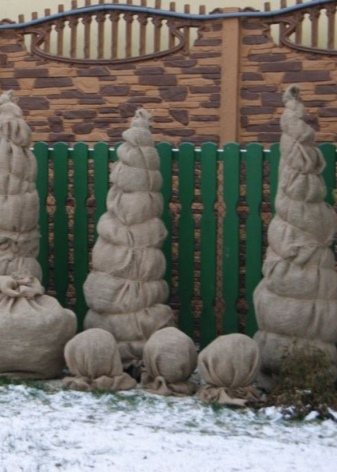

Experienced gardeners advise against covering evergreen shrubs with cellophane or polyethylene. These materials create a "greenhouse effect" that leads to the death of plants. Note that it is important to use non-woven materials that are breathable and protect from direct sunlight. It is advisable to purchase white bags.
In addition to protecting the crown, it is necessary to take care of the wintering of the thuja roots. There are several preparation options.
- The soil is mixed with the foliage.Such a "blanket" perfectly retains moisture at the root system, and humus will become an excellent plant food.
- Mulching with peat, sawdust or coniferous bark. Layer thickness - at least 10 cm.
- In addition, spruce branches are placed on the organic layer, which is removed with the arrival of heat. This moment is especially important for young trees, since their root system has not yet matured. Lapnik is able to protect the plant from "severe" frosts. Also, before warming, the thuja must be watered abundantly.
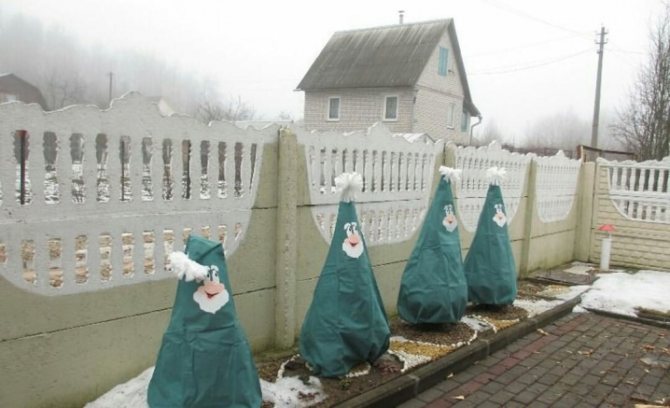

Steps to prepare thuja for winter
Thuja is considered a frost-hardy coniferous tree. The exceptions are decorative varieties and recently planted trees that have not yet gotten stronger. With them, you should carry out the actions necessary to protect against low temperatures. After proper care for the thuja in the fall, it is necessary to prepare it for the winter.
- Insulate the soil with mulching. To do this, dig up the soil near the plant's trunk, remove all weeds and apply protective material. Suitable mulch: compost, manure, dry leaves, straw. The height of the insulating layer can reach from 10 to 30 cm.
- Insulate the bushes. To do this, you need to lift the branches of the plant up, pressing them against the trunk and securing them with wire or rope. Put a bag of light colors on top of the bush: photosynthesis processes take place all year round, so the plant needs a constant source of sunlight, otherwise it may turn yellow. The protective material should not fit snugly against the wood. This is necessary for constant air circulation.
- Use 5 liter plastic containers to cover the young tree. Cut off the bottom of the bottle and place it on top of the coniferous tree.
- Preventing bark burns is another important step in caring for thuja and preparing it for the winter. To do this, starting from February 15, from the side of an active source of sunlight, install shields near the tree.
The insulation is removed immediately after a stable positive temperature is established.
The ways
Preparation of thuja for winter begins in the fall, before the first frost and snow. The simplest option is bags of a suitable size, which are fixed with twine. An adult plant with strong roots is enough to wrap with a strong rope. Another way to hide high varieties of thuja involves the construction of a frame. It is not difficult to make it - just drive in three metal pins over the top of the thuja (crosswise) and fasten. Then cover the frame with a non-woven fabric. Special shields that create shade will perfectly protect from the spring sun. Low-growing shrubs can be covered with wooden boxes. Snow from "insulated" trees must be shaken off periodically.


Many gardeners plant evergreen thuja in tubs. In winter, the plants are taken indoors or covered with non-woven fabrics. As a rule, a drain is installed at the bottom of the container, which is great for keeping moisture in the pots. It is enough to water the plant and cover it with a cotton bag, securing it around the trunk with wire or rope. It is important to know that a coniferous tree cannot survive the winter in a dark and damp room. In winter, certain conditions are necessary for thujas growing in tubs.
- The optimum temperature of the content should not exceed +5 degrees. If the thermometer in the room drops to -3, then the pots are additionally insulated.
- Regular watering. In winter, the soil in the tubs should not be allowed to dry out. This will lead to yellowing and shedding of the needles of the tree.


Also, thuja in containers winters well on a glazed balcony. Taking care of the plant will not be difficult. The tree will be able to receive the necessary lighting and fresh air. Before the onset of frost, the plant is abundantly watered and wrapped with kraft paper. During the winter, water is periodically poured into the bowls under the pots. The permissible room temperature should not exceed +12 degrees.
Features of the regions
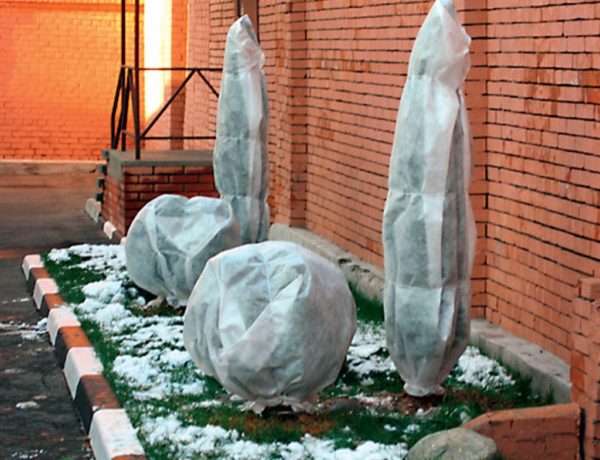

The shelter scheme for thujas for the winter may differ. It depends on the region in which the coniferous bush grows. For example, in the Middle Lane, the thickness of the mulch should be 15 cm. After warming the soil, all the necessary actions are taken to protect the crown of the plant.
In the Volga region, the difference in the preparatory procedures for the winter is to increase the thickness of the mulch by 6 cm.That is, the protective soil layer should be 21 cm.
On the territory of the Urals and Siberia, a large amount of snow falls, which can damage the thin branches of the thuja. To protect the bush, before covering it with a protective layer, build a frame made of tapered wire. This will prevent heavy snow from settling on the plant.
Suitable plot
Outdoors, thuyam will be comfortable in areas with light shading. Direct sunlight is harmful to the tree. In spring and summer, under them, it will wither and dry and, weakened, will not endure the winter well. If thuja is planted in thick shade, its decorative effect will suffer. Its development will slow down, the leaves will become pale, and will grow less often, depriving the branches of splendor.
Thuja does not like drafts and strong winds, so you need to choose a place for it that is reliably protected from them. The proximity of groundwater to the tree will only benefit. The culture grows on any soil:
- peaty;
- sandy loam;
- clayey;
- marshy.
The main condition for her is sufficient humidity. But stagnant water at the roots of a tree can destroy it. If the soil in the country house is heavy and damp, a thick (15-20 cm) layer of drainage is poured onto the bottom of the planting pit. For him, it is better to use large stones. In swampy areas, trenches are dug for drainage pipes.
The most beautiful plants are obtained in loose fertile soil, consisting of three main components:
- turf land;
- peat;
- sand.
On nutrient-poor loams and in sandy loam soil, special attention should be paid to feeding the thuja when caring for the thuja.
Mistakes to Avoid in Autumn Care
The following mistakes when preparing a thuja for winter can lead to its damage and death, so when caring for a tree, you should definitely know them.
- When does winter come? do not cover coniferous trees with protective material.
- The tree is not protected from active sunlight by shields.
- Instead of fertilizers for conifers, which you need to feed thuja, use preparations for deciduous trees.
- Pruning during the period of active sunlight. This leads to the fact that the needles acquire a brown tint.
Correctly caring for an evergreen beauty in the autumn period will not be difficult. This does not require special knowledge and special skills. It is necessary to perform all of the above simple steps to care for this coniferous tree in the fall, be sure to cover the crown of the bush, as well as insulate the soil for the winter. Then this coniferous tree will decorate the personal plot, delighting with eternal greenery for many years.
Read also: Pine green cones medicinal properties and contraindications
Thuja (or "life tree") is a coniferous plant belonging to the Cypress family. The magnificent beauty immigrated to our homesteads from the east of North America. Due to its structure and different colors, thuja is often used for landscape decoration as a hedge. This evergreen plant is quite unpretentious, however, like many other perennials, it needs to be provided with thorough care in preparation for winter, during the autumn period.
Reasons for hiding
As a rule, young immature trees need "winter clothing". Their branches are still rather weak, and the shoots are thin. They can break under the weight of snow. In addition, the root system of an annual thuja, propagated by cuttings, is on the surface - a severe snowless winter will destroy it. Also, the adhesion of snow leads to a curvature of the crown and sprinkling of the needles.Burns are another negative factor in the wintering of thuja. If the crown is exposed, then the sun's rays begin to stimulate the growth of shoots, and the roots of the plant, meanwhile, are in "hibernation". As a result:
- the color of the thuja changes;
- needles fall off;
- shoots lose their usual shape.
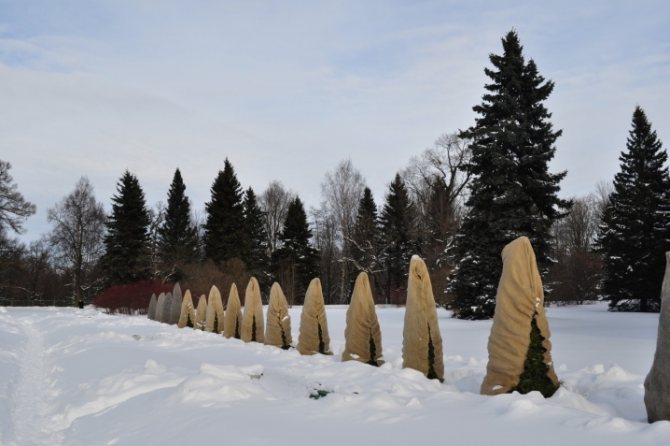

Thus, the right shelter will help the tree survive the winter outdoors.
Features of thuja care in the fall and preparation for winter - general tips and tricks
The quality of autumn care for thuja depends on how the coniferous tree will endure the winter and will look like next spring.
So, among the main measures for preparing thuja for winter are the following:
- watering;
- top dressing (if necessary);
- treatment from diseases and pests (if there are concerns about their presence);
- sanitary pruning (mandatory cleaning of the crown from old yellowed and dried needles) and shaping haircut (if required);
- mulching and shelter for the winter (protection from snow and sunlight).
Video: caring for thujas in the summer-autumn period and preparing for winter
Watering
Regular watering you need to provide the thuja growing in the region, which is characterized by dry autumn. Before the onset of frost, watering should be especially abundant (water charging irrigation): the roots will be saturated with moisture for a long time, a wet earthen lump will freeze longer, which will save the rhizome from freezing temperatures, as a result, the thuja will be more resistant to changes in temperature regimes in winter. If autumn is full of rains, the coniferous tree is practically not watered additionally (except for the final water-charging irrigation).
Top dressing
For better wintering, it will not be superfluous to apply autumn fertilizer under the thuja, although if in the spring you have already given a complex fertilizer of prolonged action, then you do not need to additionally feed.
Worth knowing! Autumn fertilizer is a fertilizer that contains a high content of phosphorus and potassium. You can purchase both a special fertilizer for conifers, and a regular one marked "autumn".


Treatment against diseases and pests
In the autumn, when preparing thuja for winter, it will be good to do preventive treatment of the ephedra from diseases and pests before sending it for the winter.
Advice! It is advisable to carry out even 2 treatments: the first - from diseases and, accordingly, the second - from pests.
- From fungal diseases (in particular from rust) - Copper sulfate, Bordeaux liquid(30 g per 10 liters - for treatment, 10 g per 10 liters - for prophylaxis) or with a special drug Hom or Abiga-peak (based on copper oxychloride), Acrobat MC.
- From pests (especially aphids) - Actellik, ordinary Fufanon or Fufanon-Nova, Rogor, Karbofos, Confidor, Decis (according to the instructions).
Industrial feeding for thuja
Biohumus-based preparations are a good addition to the diet of conifers. They provide protection against fungal spores and nutrition. Fitosporin-M and Fitosporin-K are often used. The preparations contain potassium and magnesium. The solution is prepared according to the instructions. It is better to process the conifers in the spring. Root watering or spraying can be used.
Autumn feeding of thuja actually begins in the middle of summer. The most common fertilizers for thuja are:
- Stimovit;
- Green Guy for needles;
- Embiko;
- Novofert;
- Royal Mix Grane Forte;
- Green food for conifers.
In addition to these dressings, you can use fertilizers for thuja with magnesium. Magnesium deficiency can lead to the death of needles and yellowing of the needles. It must be remembered that too acidic soil reduces the ability to absorb magnesium.
Pruning thuja in the fall
As such, autumn pruning for the winter is not required. Another thing is that you should definitely clean the tree from yellowed old needles and spend preventive pruning (cleaning), i.e. remove diseased or dry, dead branches with pruning shears, cutting them to the very base.
If you form thuja (for example, a ball), then in this case you need to regularly correct her shape and cut her hair (cut out branches that went "somewhere wrong").
Note! The main rule for pruning thuja is to cut it a little, but regularly (no more than 1/3 of the branch at a time). The bottom line is that if you miss the moment and the branch grows very much, then you will have to cut a lot and it will be easy to make a mistake, which will result in a hole in the crown that will overgrow for a long time.
Important! Desirable do not cut the thuja in the first year of planting: let it calmly settle down in a new place, and next year start forming the crown.
Naturally, if you do not cut the thuja at all, then it can overgrow, because of which it will be poorly blown out and illuminated inside due to excessive thickening, which will certainly lead to sad consequences in the form of fungal diseases. Therefore, periodically you also need to perform thinning pruning, removing thickening branches.
Interesting! Tuya Smaragd independently acquires an almost perfect shape and does not need any haircut. But Tue Brabant, for example, requires a regular haircut, without which her crown becomes loose and empty, in other words, the ephedra looks unsightly.
Concerning terms of pruning thujathen the best time is it's late spring - early summerwhen the buds have just blossomed and young shoots have appeared, or late summer - early autumnwhen the tree is already preparing for winter.
Advice! Pruning should only be done in dry weather. If you do this in the rain, then all kinds of diseases can get into open wounds.
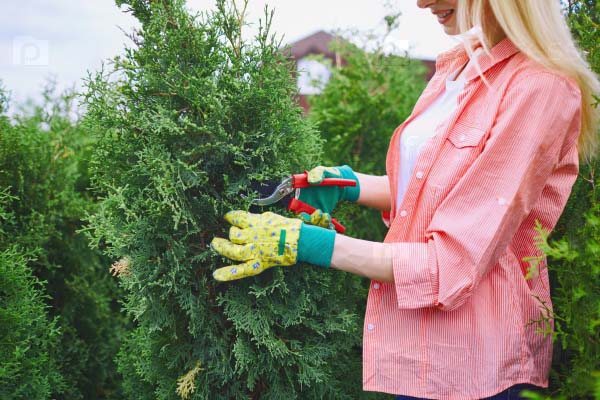

Video: how to crop the autumn, spring or summer
The main activities that will allow you to save thuja in winter
To make your green beauty pleasing to the eye, you need to take care of her. If we consider such a species as western thuja and all its forms, then in general we can say that these plants are unpretentious and tolerate negative temperatures well. However, other winter factors can be harmful. In order for the thuja to winter well, we begin preparation in the fall.
The first thing to do is to cover the thuja for the winter., moreover, only young plants, which are still weak, with thin tender shoots (the first year of planting). The material for these purposes should be white, non-woven (for example, spunbond, agrotherm, lutrasil). It is best to prepare a bag from the selected material, which is simply put on the plant. Moreover, he should not tighten the thuja tightly. If you wish, you can build a frame made of wood, which is arranged around the plant. Then the frame is covered with material.


The shelter will allow the snow not to linger on the top of the thuja, it will roll... If you do not organize a shelter, then the top may deform, and wide spreading plant specimens (for example, a spherical shape) will acquire an unattractive appearance, because the snow will push the center, pushing the branches apart, and as a result, a void will form. In this case, the crown can be previously fixed with a rope.
Then you need to insulate the root system.... For this purpose, you can use the leaves, which are mixed with the ground. They will not only protect the roots from frost, but will also retain moisture, and over time they will rot and become an additional fertilizer.
The measures considered must be carried out in the second half of autumn, preferably before snow falls. Overwintering of adult plants can take place without shelter.
In winter, it is worth making sure that the thuja is not covered with snow, which can lead to the needling of the needles. The same rule applies to those who are used to throwing snow from paths onto plants, mistakenly assuming that it will be warmer for them.
What to do if thuja turns yellow in autumn
Thuja needles can turn yellow in the fall for a natural reason - due to the loss of chlorophyll, a substance that provides food for the needles.They turn yellow, dry out and die, and then new green needles appear in the same place. it normal natural life cyclethat happens to thuja every 3-6 years.
Also, at the end of autumn, thuja needles may turn yellow due to natural defensive reaction of ephedra to a cold snap. ZThen she herself will turn green again.
Moreover, this (yellowing due to stress) will surely happen if the thuja does not have time to adapt to a new place when planting in early autumn or late summer.
Mulching and pruning
Caring for thuja also involves the regular removal of weeds, loosening and mulching the soil under the plants. Any organic material can be scattered under them:
- sawdust;
- straw;
- compost;
- chopped nutshells.
They will stop the growth of weeds and retain moisture in the soil, improving the condition of the tree. Mulch can also serve as a decorative function if colored sawdust is used for it.
To make the tree look spectacular, its crown is formed. Only plants that have taken root well on the site are sheared, and at least 2 years have passed since planting. The first pruning is more of a sanitary function. Tuyu gets rid of dry, damaged, diseased and weakened branches and determines how thick the crown is. The more often you trim, the more lush the tree will be.
The main pruning is done in the spring, in April, choosing dry weather for it. During the season, if necessary, it is supplemented with corrective haircuts. When pruning, the length of the branches is shortened by no more than a third. In order for the thuja in the garden to be healthy and beautiful, air must circulate freely between its branches. For this, it is recommended to get rid of all the shoots of the one-year growth. With the help of trimming, the thuja can be turned into a ball, cube, column, spiral, steps, the figure of an animal or a fairytale hero - it all depends on the gardener's imagination and experience.
How to cover thuja
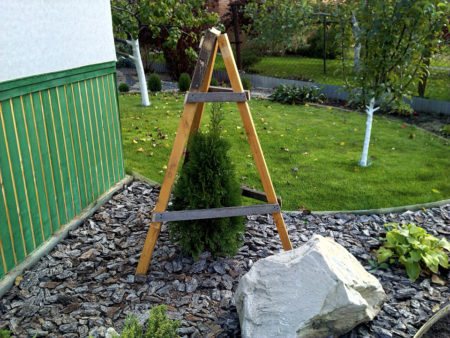

Shelter of a thuja for the winter is a simple process, but a little painstaking, since accuracy will be required. Tie the branches of the tree with a thick twine to begin with. Do not overtighten the twine, otherwise it will be difficult for the branches. It is enough to fix the crown so that the snow cannot fall on the branches. Gather the branches up towards the center of the tree, and then start tying in a circle. Start the process at the base of the tree and gradually work your way up to the top.
If heavy snow falls in your area with the onset of winter, it makes sense to build a frame. It is necessary to drive 3 pins made of metal or wood into the ground next to the crop. They should intersect at one point - above the top of the tree. Then wrap the frame with an air-permeable covering material. Be sure to reinforce the material to the frame so that it will not be blown away by the wind gust. Tie it with twine, for example.


In stores that offer a large selection of garden tools, sometimes there are special covers for plants on sale. Get them, they are easy to use and will serve you for more than a dozen years. The cover just needs to be put on and spread on the thuja, then the plant will stand wonderfully all winter, until the beginning of spring. In the spring, remove the cover, wash and dry; you will not need it until autumn.
Another way to hide is by installing a sunscreen. It can be a wooden box or a homemade device. Drive the pegs into the ground parallel to each other. Cover the space between the pegs with roofing material and a special sun-protection cloth. Such a shelter will prevent the needles from burning out even in spring, when the sun is very active.
To protect thuja in winter, use a few good tips:
- annual and biennial trees are covered first, even before the snow falls;
- if a lot of snow fell during the winter, remove it from the shelter;
- the shelter can be removed after the snow begins to melt.
It is more convenient to cover the tree with two or three people.Ask someone in your family to help you, and you will be done in just a few minutes.
Loosening
Since the roots of the thuja are located relatively shallow, you need to loosen no more than 10 centimeters in depth.
Also, in early spring, the tree needs to be well watered. Mulching around the trunk will protect the tree from overheating, drying out and freezing during this period.
Peat, sawdust, bark, compost can serve as mulch (the layer should be about 7 centimeters thick). This event has a very beneficial effect on the health of the tree and contributes to a longer moisture retention.
If there is a lack of care, thuja can grow and branch poorly, its needles can turn yellow and fall off.
How to fertilize correctly
To get the most out of your nutritional formula, there are a few simple rules to follow:
- breaks between feeding with different microelements should be two weeks;
- with the onset of autumn, the introduction of all types of minerals and organics stops (with the exception of the southern regions of the country);
- do not water the dry soil of the trunk circle with nutrients. The day before feeding the thuja, it is necessary to water it with water;
- do not use different complex preparations containing the same microelement, an excess of it may occur.
IMPORTANT! Apply top dressing no later than the end of August. Untimely stimulation of vegetation will have a detrimental effect on the wintering of plants.
There are two main ways of feeding thuja:
- Root introduction.
- Foliar dressing.
Consider both options p>
Autumn problems and methods of solving them
Failure to comply with the cultivation technology and violations in the care regime often cause problems in the autumn. A diseased plant may shed needles or turn very yellow.
How to crop thuja in autumn (video)
For what reason does thuja shed its needles in the fall
There are several reasons for the needles to fall, but the most common and easily identifiable categories include:
- too strong and prolonged frosts, which have an extremely negative effect on the appearance of the crown of not too frost-resistant varieties in the absence of high-quality insulation;
- severe drought in the autumn in the absence of high-quality freezing measures and drying out of the root system;
- sunburn, which severely burns the youngest and most recently planted plants, in the absence of shading;
- too late and abundant application of chemical fertilizers, causing burns to the root system.
Among other things, an ornamental culture can be affected by some diseases and plant parasites, including phytophthora, brown shoots, rust and shute, thuja false shield, thuja moth, wireworm, thuja bark beetle and spider mites.


For what reason thuja turns yellow in autumn
The natural browning of the ephedra crown is often observed at the end of the growing season with the onset of late autumn. In this way, the plant adapts to the upcoming low-temperature regimes. However, sometimes pronounced yellowing is the result of significant errors in care and violations of cultivation technology.
therefore it is strictly forbidden to carry out late autumn watering and transplanting, as well as planting seedlings in sunny areas without the use of a shade shelter. Significant yellowing of the needles can also be caused by excessive late fertilization and insufficient oxygen supplied to the root system of an ornamental crop.
If the yellowing of the needles is caused by fungal infections, then it is advisable to perform a preventive treatment of the crown with zircon or any copper-containing preparations, including "HOM" and "Bordeaux liquid". The spilling of the near-trunk circles with a solution based on foundationol, as well as spraying the crown with the drug "Tornado Anti-tick", has very high efficiency.Also in the fall, experts often recommend the use of the drug "Decis".
Folk recipes
Fertilizer for thuja can be made up by folk remedies.
Herbs
Fertilizing solutions are often made on the basis of herbs, the chemical composition of which contains nitrogen: clover, nettle, euphorbia, wheatgrass, wood lice and dandelion.
For the preparation of working fluids, the vegetation is harvested until the seeds appear.
The chopped grass is put into a plastic barrel (2/3 full), water is added. Ammonium nitrate or urea is added to the mixture in the calculation of 5 tbsp. for every 50 liters.
The container is covered with a lid or polyethylene, holes are made for the release of gases and placed in the sun for 1-1.5 weeks, stirring occasionally.
You can increase efficiency by adding wood ash and bone meal.
The ready-to-use herbal solution turns dark brown. The working liquid for top dressing is diluted with water in a ratio of 1:10.
Yeast
They contain in the chemical composition amino acids and trace elements necessary for the ephedra to stimulate growth and increase immunity.
Cooking recipe: 35 g of diluted dry yeast, 2 tbsp. granulated sugar is dissolved in 0.7 liters of water and placed in a warm place.
The liquid is ready for use after the end of fermentation. For irrigation, the concentrate is diluted in water at the rate of 1 tbsp. for every 10 liters.
Time of work
It is not recommended to feed the thuja later than mid-September. As the plant prepares for rest - the growth of branches stops, they ripen. And top dressing will only stimulate growth, young shoots will leave fragile in the winter and die. Therefore, the end of August is considered a favorable time.
In some situations, feeding with nutrients in the fall is necessary:
- to improve the general agricultural background;
- quickly saturate the soil with useful substances;
- after the autumn transplant.
To get the most out of your nutritional formula, there are a few simple rules to follow:
- the minimum break between dressings should be 14 days;
- do not water dry soil on the trunks with useful substances, and water it well a day before feeding;
- do not use various fertilizer complexes that contain the same substance.
A warning! Apply top dressing no later than late August - early September. Untimely stimulation of vegetation will negatively affect the outcome of thuja wintering.
Transfer
Thuja can be transplanted from March to November. If done correctly, they tolerate it well. Having prepared the planting pit in advance, they begin to extract the tree. A circle with a diameter of 1 m is outlined around it. The trunk of the thuja should be in its center.
Armed with a sharp spatula, the circle is pierced along its entire length. Then the soil is gently pryed. Assistants are indispensable here. The thuja taken out of the ground is loaded onto a trolley and transported to a new place.
The elegant beauty of thuja and the simplicity of its cultivation make it a favorite of gardeners and landscape designers. This evergreen tree is appropriate everywhere: in the country, in the front garden, in the park. It also has useful properties. If you stay close to thujas for 30 minutes or more, thoughts and feelings will come in order, nervous tension will disappear. They also have a beneficial effect on the air, saturating it with oxygen, purifying and killing harmful microorganisms.
You can experiment with planting thuja endlessly. They are equally effective in hedges and in single placement, often used to decorate paths. Their crown can be given any shape, turning the dacha into a fabulous corner.
Any shrub or tree needs to be prepared for the winter cold so that the plant can tolerate them as easily as possible. It is quite simple to care for thuja: it does not require special fertilizers, it is not difficult to cut it off, it is not necessary to constantly feed the soil.But even with such minimal care, thuja will delight you with its blooming appearance.
If you want to decorate your summer cottage with trees, then thuja will be an excellent option for decorating any area.
If you want to decorate your summer cottage with trees, then thuja will be an excellent option for decorating any area. This evergreen plant from the Cypress family amazes with a variety of shades, and due to its excellent winter hardiness, it is excellent for central Russia.
The most popular are 14 types of western thuja, which are chosen by gardeners:
- Brabant.
It is resistant even to severe frosts, has a rich green color. - Emerald.
Dark green, needs abundant watering. - Columna.
With a dense narrow crown, dark green needles do not fade even in summer. - Holmstrup.
Does not require careful maintenance, perfect for suburban areas that are not often visited. Cold resistant. - Fastigiata.
Due to the conical crown, it looks like a cypress. Prefers moist soil and sunny areas. - Sunkist.
An interesting species with a slightly sloppy shape, which the tree acquires due to the numerous well-developed branches. The color is green; in summer, the needles fade to a yellow tint. - Wagneri.
Gray-green with a copper sheen. - Claude of Gold.
With lemon or orange color, the needles are tender and thin. - Globoza.
The bluish tint is most pronounced during the winter months. - Woodwardy.
It is famous for its rich emerald needles. - Stolvik.
It tolerates winter well, does not suffer from bright sunlight. - Danica.
The globular tree is light green and does not suffer from severe drought. - Golden Globe.
The variety is interesting for its unusual golden color. Demanding care. - Hoseri.
The deep color takes on a light grayish tone in winter. Doesn't need a haircut.
Autumn watering of conifers
For conifers, abundant autumn watering is very important. Such plants have a very dense and large crown, it almost does not allow moisture to pass through. The ground remains almost dry under the spruce even after the heaviest rainfall.
If there was very little rainfall in the fall, it is necessary to help the plant and produce abundant watering. Evaporation of moisture in conifers occurs until frost. With insufficient watering, plants suffer from drought and frost.
You may be interested in: Land cultivation in a greenhouse in the fall. What are the ways
How to choose a covering material
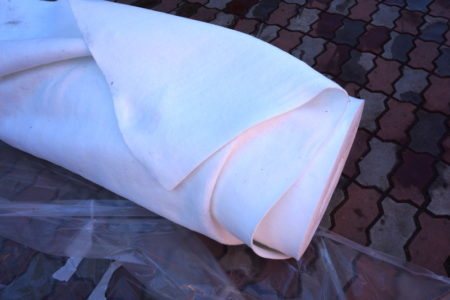

Choose the material for covering the thuja depending on its throughput, it must be high and allow air to penetrate inside. It is strictly forbidden to take material that does not allow air to pass through, for example, cellophane film. A greenhouse effect will develop under it, as a result of which the tree will begin to rot, shed the needles and become sick. The best material for a winter shelter is:
Choose a material with a white color, in addition to heat, it will reflect the sun's rays from the tree, thus the needles will not "burn". Therefore, if you chose a black roofing felt for shelter, wrap a white sheet or duvet cover over it.
Insulation of roots
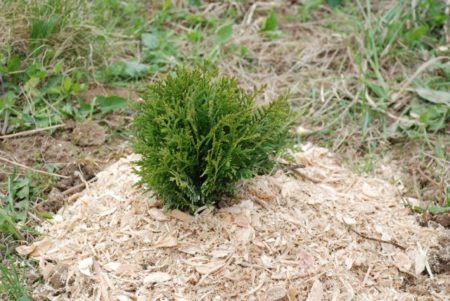

In addition to keeping the crown warm and from sun protection, you need to think about how to insulate the root system. The roots of young plants are exposed to frost, and the plant itself will quickly die if the roots are frozen. Suitable for warming the root system:
- peat or any other organic component. The main condition is that the mulch must have a loose layer;
- a mixture of fallen autumn leaves with earth or humus. In addition to protection from cold weather, such a mixture will eventually become an excellent fertilizer for the root system;
- sawdust, straw.
The thickness of the mulch layer should be at least 5 cm, but not more than 10 cm. The mulch is placed near the tree trunk circle, and the lapotnik is laid on top of it. It will protect the root system from rodents and press down on the mulch.
When is the best time to hide
You need to close a tree in different regions in different ways for the winter.It depends on the onset of cold weather in a particular region, on the length of winter and on its average temperature. So, in the southern strip, the tree does not have to be covered for the winter. It grows quietly both in the summer cottage and in the forest. But for other regions, in order to preserve thuja in winter, you need to make a little effort.
Middle lane
Cooling in the middle lane begins in late October or early November. At this time, when there is still no snow, a 5-centimeter layer of mulch is laid near the tree trunk circle, covered with spruce branches and the culture is left to winter. Around the second part of winter, from the end of January, sun-reflecting screens are installed next to the tree to protect the needles. There is no need to wrap the crown with agrofibre, since the temperature in the Middle Lane rarely drops below +20 degrees, and overheating is dangerous for a tree.
Volga region
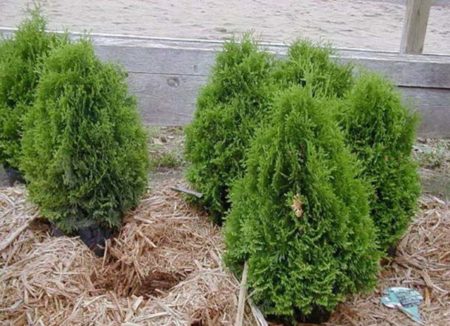

Winter comes to the Volga region at the end of autumn, so from the end of October you can start winter preparation. For the Volga region, as well as for the Middle zone, only mulch is laid for the wintering of thuja. The layer can be put thicker, its height will be about 10 cm. Only young trees can be sheltered from the cold. Take a 5 liter plastic bottle, cut off the bottom and cover the tree with it. To keep the color out of the plastic, wrap it in a white pillowcase. If your thuja is more than 4 years old, then do not wrap it up for the winter, it will stand remarkably well.
Ural and Siberia
In the northern part of the country, winter comes very early, literally in mid-October, so preparations begin earlier than in the central part of Russia. To begin with, the soil is mulched with a layer of peat or sawdust 10 cm thick. Spruce branches are placed on top of the mulch. Then a tapered wire frame is made. Agrofibre or any protective material is pulled over the wire, fixed on top with a twine so that it does not fly off. In addition to the wire frame, you can wrap it in spunbond. The shelter from the tree is removed in Siberia no earlier than mid-March, since the frost lasts a long time in the region.
How to feed thuja when planting
How to feed thuja when planting in autumn and spring
The first feeding when planting seedlings is fundamental. If you prepare the planting pit properly (do not skimp on nutrients), additional feeding will not be needed during the first year of growth. Also, do not forget that a young thuja will tolerate a lack of nutrients better than an excess.
So, for the most important first feeding, we need dry organic matter: humus or compost and wood ash. With a planting pit diameter and depth of 1 meter, the nutrient base should consist of 2 compost / humus buckets and 3 kg of wood ash. We distribute the wood ash evenly along the bottom, and mix the humus with the ground and use it for backfill.



